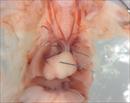Dnah5b2b002Clo
Chemically induced Allele Detail
|
|
| Symbol: |
Dnah5b2b002Clo |
| Name: |
dynein, axonemal, heavy chain 5; Bench to Bassinet Program (B2B/CVDC), mutation 002 Cecilia Lo |
| MGI ID: |
MGI:5294340 |
| Synonyms: |
Scar, Scaramanga |
| Gene: |
Dnah5 Location: Chr15:28203898-28472198 bp, + strand Genetic Position: Chr15, 10.9 cM
|
| Alliance: |
Dnah5b2b002Clo page
|
|
Mutant 002-044-NG exhibits heterotaxy with dextrocardia and abnormal position of the great arteries which is diagnosed as DORV by EFIC imaging
Show the 20 phenotype image(s) involving this allele.
|

|
|
| Strain of Origin: |
C57BL/6J
|
| Project Collection: |
B2B/CvDC
|
|
| Allele Type: |
|
Chemically induced (ENU) |
| Mutation: |
|
Single point mutation
|
| |
|
Mutation details: This ENU-induced mutation was isolated in a screen at the University of Pittsburgh. The molecular lesion is a T to C substitution at coding nucleotide 13169 in exon 76 of the cDNA (c.13169T>C, NM_133365). This changes the leucine residue to proline at position 4390 of the encoded protein (p.L4390P).
(J:175213)
Additional
incidental mutations
were detected in sequencing for the causative mutation,
Dnah5b2b002Clo, and may be present in stocks carrying this mutation.
|
|
|
View phenotypes and curated references for all genotypes (concatenated display).
|
|
|
|
|
|
|
|
Summative Diagnosis
Cardiovascular defects:Situs inversus totalis and heterotaxy with congenital heart disease such as dextrocardia, double outlet right ventricle (DORV), transposition of the great arteries (TGA), ventricular (VSD), atrial (ASD), and atrioventricular septal defect (AVSD), and superior-inferior ventricles.
Non-cardiovascular defects: Abnormal thoracic and abdominal organ situs anomalies, such as malalignment of sternal vertebrae, right pulmonary isomerism, hypoplastic spleen, as well as inverted liver and lung. Also observed were kidney defects such as duplex, cystic, and hydronephrotic. Tracheal airway cilia were immotile.
|
 Analysis Tools
Analysis Tools




